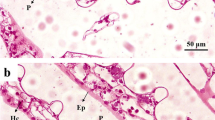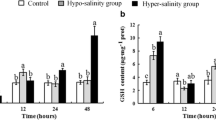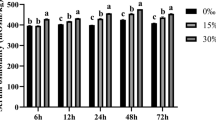Abstract
In the present study, acute stress responses of adult female Notopterus chitala were scrutinized by antioxidant status and inflammation reaction in the gill and liver at five different salinity exposures (0, 3, 6, 9, 12 ppt). Oxidative defense was assessed by determining superoxide dismutase (SOD), catalase (CAT), glutathione S-transferase, and glutathione reductase activities, while malondialdehyde (MDA), glutathione, and xanthine oxidase levels were determined as indicators of oxidative load. Pro-inflammatory cytokines (IL-1β, IL-6, IL-10, and TNFα) and caspase 1 levels were also analyzed. Expression levels of transcription factors (NRF2 and NF-κB) and molecular chaperons (HSF, HSP70, and HSP90) were estimated to evaluate their relative contribution to overcome salinity stress. MDA showed a significant (P < 0.05) increase (gill, + 25.35–90.14%; liver, + 23.88–80.59%) with salinity; SOD (+ 13.72–45.09%) and CAT (+ 12.73–33.96%) exhibited a sharp increase until 9 ppt, followed by a decrease at the highest salinity (12 ppt) (gill, − 3.92%; liver, − 2.18%). Levels of cytokines were observed to increase (+ 52.8–127.42%) in a parallel pattern with increased salinity. HSP70 and HSP90 expressions were higher in gill tissues than those in liver tissues. NRF2 played pivotal role in reducing salinity-induced oxidative load in both the liver and gills. Serum cortisol and carbonic anhydrase were measured and noted to be significantly (P < 0.05) upregulated in salinity stressed groups. Gill Na+-K+-ATPase activity decreased significantly (P < 0.05) in fish exposed to 6, 9, and 12 ppt compared to control. Present study suggests that a hyperosmotic environment induces acute oxidative stress and inflammation, which in turn causes cellular death and impairs tissue functions in freshwater fish species such as Notopterus chitala.





Similar content being viewed by others
Data availability
The datasets generated and/or analyzed during the current study are not publicly available but are available from the corresponding author on reasonable request.
References
Abo-Al-Ela HG, El-Nahas AF, Mahmoud S, Ibrahim EM (2017) Vitamin C modulates the immunotoxic effect of 17α-methyltestosterone in Nile tilapia. Biochemistry 56:2042–2050. https://doi.org/10.1021/acs.biochem.6b01284
Aebi H (1984) Catalase in vitro. Methods Enzymol 105:121–126
Aksoy Y, Balk M, ÖĞÜŞ H, Özer N (2004) The mechanism of inhibition of human erythrocyte catalase by azide. Turk J Biol 28:65–70
Agrahari S, Gopal K (2008) Inhibition of Na+–K+-ATPase in different tissues of freshwater fish Channa punctatus (Bloch) exposed to monocrotophos. Pestic Biochem Physiol 92:57–60. https://doi.org/10.1016/j.pestbp.2008.06.003
Banaee M, Mohammadipour S, Madhani S (2015) Effects of sublethal concentrations of permethrin on bioaccumulation of cadmium in zebra cichlid (Cichlasoma nigrofasciatum). Toxicol Environ Chem 97:200–207. https://doi.org/10.1080/02772248.2015.1031668
Barton BA, Iwama GK (1991) Physiological changes in fish from stress in aquaculture with emphasis on the response and effects of corticosteroids. Ann Rev Fish Dis 1:3–26. https://doi.org/10.1016/0959-8030(91)90019-G
Barton BA (2002) Stress in fishes: a diversity of responses with particular reference to changes in circulating corticosteroids. Integr Comp Biol 42:517–525. https://doi.org/10.1093/icb/42.3.517
Biales AD, Bencic DC, Flick RL, Blocksom KA, Lazorchak JM, Lattier DL (2011) Proteomic analysis of a model fish species exposed to individual pesticides and a binary mixture. Aquat Toxicol 101(1):196–206
Bird S, Wang T, Zou J, Cunningham C, Secombes CJ (2002) The first cytokine sequence within cartilaginous fish: IL-1β in the small spotted catshark (Scyliorhinus canicula). J Immunol 168:3329–3340. https://doi.org/10.4049/jimmunol.168.7.3329
Blondeau-Bidet E, Hiroi J, Lorin-Nebel C (2019) Ion uptake pathways in European sea bass Dicentrarchus labrax. Gene: 692:126-137 https://doi.org/10.1016/j.gene.2019.01.006
Bœuf G, Payan P (2001) How should salinity influence fish growth? Comp Biochem Physiol C Toxicol Pharmacol 130:411–423. https://doi.org/10.1016/S1532-0456(01)00268-X
Bray WA, Lawrence AL, Leung-Trujillo JR (1994) The effect of salinity on growth and survival of Penaeus vannamei, with observations on the interaction of IHHN virus and salinity. Aquac 122:133–146. https://doi.org/10.1016/0044-8486(94)90505-3
Choi K, Kim Y, Park J, Park CK, Kim M, Kim HS, Kim P (2008) Seasonal variations of several pharmaceutical residues in surface water and sewage treatment plants of Han River, Korea. Sci Total Environ 405:120–128. https://doi.org/10.1016/j.scitotenv.2008.06.038
Chondar SL (1999) Biology of finfish and shellfish. SCSC Publishers, Howrah, West Bengal, India. xvi, 514 p
Cuadrado A, Manda G, Hassan A, Alcaraz MJ, Barbas C, Daiber A, Ghezzi P, León R, López MG, Oliva B, Pajares M, Rojo AI, Robledinos-Antón N, Valverde AM, Guney E, Schmidt HHHW (2018) Transcription factor NRF2 as a therapeutic target for chronic diseases: a systems medicine approach. Pharmac Rev 70:348–383. https://doi.org/10.1124/pr.117.014753
Dang ZC, Flik G, Ducouret B, Hogstrand C, Bonga SEW, Lock RA (2000) Effects of copper on cortisol receptor and metallothionein expression in gills of Oncorhynchus mykiss. Aquat Toxicol 51:45–54. https://doi.org/10.1016/s0166-445x(00)00102-8
Deane EE, Woo NYS (2005) Cloning and characterization of the hsp70 multigene family from silver sea bream: modulated gene expression between warm and cold temperature acclimation. Biochem Biophys Res Commun 330:776–783. https://doi.org/10.1016/j.bbrc.2005.03.039
Deane EE, Woo N (2011) Advances and perspectives on the regulation and expression of piscine heat shock proteins. Rev Fish Biol Fisher 21:153–185. https://doi.org/10.1007/s11160-010-9164-8
Dinkova-Kostova AT (2012) The role of sulfhydryl reactivity of small molecules for the activation of the KEAP1/NRF2 pathway and the heat shock response. Scientifica 19 p. https://doi.org/10.6064/2012/606104
Dhabhar FS (2008) Enhancing versus suppressive effects of stress on immune function: implications for immunoprotection versus immunopathology. All Asth Clin Immun 4:2–11. https://doi.org/10.1186/1710-1492-4-1-2
Draper HH, Hadley M (1990) Malondialdehyde determination as index of lipid Peroxidation. Methods Enzymol 186:421–431
Edeline E, Dufour S, Elie P (2005) Role of glass eel salinity preference in the control of habitat selection and growth plasticity in Anguilla anguilla. Mar Ecol Prog Ser 304:191–199
Elarabany N, Bahnasawy M, Edrees G, Alkazagli R (2017) Effects of salinity on some haematological and biochemical parameters in Nile tilapia Oreochromus niloticus. Agric For Fish 6:200–205. https://doi.org/10.11648/j.aff.20170606.13
Evans DH, Piermarini PM, Choe KP (2005) The multifunctional fish gill: dominant site of gas exchange, osmoregulation, acid-base regulation, and excretion of nitrogenous waste. Physiol Rev 85:97–177. https://doi.org/10.1152/physrev.00050.2003
Evans DH (2008) Teleost fish osmoregulation: what have we learned since August Krogh, Homer Smith, and Ancel Keys. Am J Physiol Regul Integr Comp Physiol 295:R704–R713. https://doi.org/10.1152/ajpregu.90337.2008
Evans TG, Kültz D (2020) The cellular stress response in fish exposed to salinity fluctuations. J Exp Zool A Ecol Integr Physiol 333:421–435. https://doi.org/10.1002/jez.2350
Ewing JF, Janero DR (1995) Microplate superoxide dismutase assay employing a nonenzymatic superoxide generator. Anal Biochem 232:243–248. https://doi.org/10.1006/abio.1995.0014
Georgalis T, Perry SF, Gilmour KM (2006) The role of branchial carbonic anhydrase in acid-base regulation in rainbow trout (Oncorhynchus mykiss). J Exp Biol 209:518–530. https://doi.org/10.1242/jeb.02018
Ghosh M, Ta S, Banerjee M, Mahiuddin M, Das D (2018) Exploring the scope of photo-induced electron transfer–chelation-enhanced fluorescence–fluorescence resonance energy transfer processes for recognition and discrimination of Zn2+, Cd2+, Hg2+, and Al3+ in a ratiometric manner: application to sea fish analysis. ACS Omega 3:4262–4275. https://doi.org/10.1021/acsomega.8b00266
Gilmour KM, Perry SF (2009) Carbonic anhydrase and acid–base regulation in fish. J Exp Biol 212:1647–1661. https://doi.org/10.1242/jeb.029181
Gilmour KM, Perry SF, Esbaugh AJ, Genz J, Taylor JR, Grosell M (2012) Compensatory regulation of acid–base balance during salinity transfer in rainbow trout (Oncorhynchus mykiss). J Comp Physiol B 182:259–274. https://doi.org/10.1007/s00360-011-0617-8
Gonçalves AMM, Castro BB, Pardal MA, Gonçalves F (2007) Salinity effects on survival and life history of two freshwater cladocerans (Daphnia magna and Daphnia longispina). Ann Limnol-Int J Limnol 43:13–20. https://doi.org/10.1051/limn/2007022
Habig WH, Pabst MJ, Jakoby WB (1974) Glutathione S-transferases the first enzymatic step in mercapturic acid formation. J Biol Chem 249:7130–7139
Hansen AC, Rosenlund G, Karlsen Ø, Koppe W, Hemre GI (2007) Total replacement of fish meal with plant proteins in diets for Atlantic cod (Gadus morhua L.) I—Effects on growth and protein retention. Aquac 272(1–4): 599–611.
Hirose S, Kaneko T, Naito N, Takei Y (2003) Molecular biology of major components of chloride cells. Comp Biochem Physiol B 136:593–620. https://doi.org/10.1016/s1096-4959(03)00287-2
Hwang PP, Lee TH (2007) New insights into fish ion regulation and mitochondrion-rich cells. Comp Biochem Physiol A Mol Integr Physiol 148:479–497. https://doi.org/10.1016/j.cbpa.2007.06.416
Imsland AK, Foss A, Gunnarsson S, Berntssen MH, FitzGerald R, Bonga SW, Ham E, Naevdal G, Stefansson SO (2001) The interaction of temperature and salinity on growth and food conversion in juvenile turbot (Scophthalmus maximus). Aquac 198:353–367. https://doi.org/10.1016/S0044-8486(01)507-5
Kim JH, Park HJ, Kim KW, Hwang IK, Kim DH, Oh CW, Lee JS, Kang JC (2017) Growth performance, oxidative stress, and non-specific immune responses in juvenile sablefish, Anoplopoma fimbria, by changes of water temperature and salinity. Fish Physiol Biochem 43:1421–1431. https://doi.org/10.1007/s10695-017-0382-z
Kirici M, Nedzvetsky VS, Agca CA, Gasso VY (2019) Sublethal doses of copper sulphate initiate deregulation of glial cytoskeleton, NF-kB and PARP expression in Capoeta umbla brain tissue. Regul Mech Biosyst 10: 103–110. https://doi.org/10.15421/021916
Kumar S, Moniruzzaman M, Chakraborty A, Sarbajna A, Chakraborty SB (2021) Crosstalk between heat shock proteins, NRF2, NF-κB and different endogenous antioxidants during lead-induced hepatotoxicity in Puntius ticto. Aquat Toxicol 233:105771. https://doi.org/10.1016/j.aquatox.2021.105771
Leite T, Branco P, Ferreira MT, Santos JM (2022) Activity, boldness and schooling in freshwater fish are affected by river salinization. Sci Total Environ 819:153046. https://doi.org/10.1016/j.scitotenv.2022.153046
Li E, Chen L, Zeng C, Chen X, Yu N, Lai Q, Qin JG (2007) Growth, body composition, respiration and ambient ammonia nitrogen tolerance of the juvenile white shrimp, Litopenaeus vannamei, at different salinities. Aquac 265:385–390. https://doi.org/10.1016/j.aquaculture.2007.02.018
Lushchak VI (2011) Environmentally induced oxidative stress in aquatic animals. Aquat Toxicol 101:13–30. https://doi.org/10.1016/j.aquatox.2010.10.006
Martinez-Alvarez RM, Hidalgo MC, Domezain A, Morales AE, García-Gallego M, Sanz A (2002) Physiological changes of sturgeon Acipenser naccarii caused by increasing environmental salinity. J Exp Biol 205:3699–3706
McCormick SD (2011) The hormonal control of osmoregulation in teleost fish. Life Sci 1:1466–1473. https://doi.org/10.1016/B978-0-12-374553-8.00212-4
McCormick SD, Moyes CD, Ballantyne JS (1989) Influence of salinity on the energetics of gill and kidney of Atlantic salmon (Salmo salar). Fish Physiol Biochem 6:243–254. https://doi.org/10.1007/BF01875027
Mitra A, Mukhopadhyay PK, Homechaudhuri S (2018) An overview of biology and culture potentials of Humped featherback Chitala chitala (Hamilton, 1822)–a new candidate for aquaculture diversification. Rev Fish Sci Aquac 26(3):371–380
Moniruzzaman M, Hasan KN, Maitra SK (2016) Melatonin actions on ovaprim (synthetic GnRH and domperidone)-induced oocyte maturation in carp. Reproduction 151:285–296. https://doi.org/10.1530/REP-15-0391
Moniruzzaman M, Mukherjee J, Jacquin L, Mukherjee D, Mitra P, Ray S, Chakraborty SB (2018) Physiological and behavioural responses to acid and osmotic stress and effects of Mucuna extract in Guppies. Ecotox Environ Safe 163:37–46. https://doi.org/10.1016/j.ecoenv.2018.07.053
Moniruzzaman M, Mukherjee M, Das D, Chakraborty SB (2020) Effectiveness of melatonin to restore fish brain activity in face of permethrin induced toxicity. Environ Pollut 266:115230. https://doi.org/10.1016/j.envpol.2020.115230
Morgan MJ, Liu Z-g (2011) Crosstalk of reactive oxygen species and NF-κB signaling. Cell Res 21:103–115. https://doi.org/10.1038/cr.2010.178
Mukherjee J, Moniruzzaman M, Chakraborty SB, Lek S, Ray S (2017) Towards a physiological response of fishes under variable environmental conditions: an approach through neural network. Ecol Indic 78:381–394. https://doi.org/10.1016/j.ecolind.2017.03.038
Mukherjee A, Bhowmick AR, Mukherjee J, Moniruzzaman M (2019) Physiological response of fish under variable acidic conditions: a molecular approach through the assessment of an eco-physiological marker in the brain. Environ Sci Pollut Res 26:23442–23452. https://doi.org/10.1007/s11356-019-05602-3
Murata M, Fukushima K, Takao T, Seki H, Takeda S, Wake N (2013) Oxidative stress produced by xanthine oxidase induces apoptosis in human extravillous trophoblast cells. J Reprod Dev 59:7–13. https://doi.org/10.1262/jrd.2012-053
Nepal V, Fabrizio MC (2019) High salinity tolerance of invasive blue catfish suggests potential for further range expansion in the Chesapeake Bay region. PLoS ONE 14(11):e0224770. https://doi.org/10.1371/journal.pone.0224770
Nordlie FG (2009) Environmental influences on regulation of blood plasma/serum components in teleost fishes: a review. Rev Fish Biol Fish 19:481–564. https://doi.org/10.1007/s11160-009-9131-4
Oruc EÖ (2010) Oxidative stress, steroid hormone concentrations and acetylcholinesterase activity in Oreochromis niloticus exposed to chlorpyrifos. Pest Biochem Physiol 96:160–166. https://doi.org/10.1016/j.pestbp.2009.11.005
Oruc E (2012) Oxidative stress responses and recovery patterns in the liver of Oreochromis niloticus exposed to chlorpyrifos-ethyl. Bull Environ Contam Toxicol 88:678–84. https://doi.org/10.1007/s00128-012-0548-4
Oruc EO, Sevgiler Y, Uner N (2004) Tissue-specific oxidative stress responses in fish exposed to 2, 4-D and azinphosmethyl. Comp Biochem Physiol C Toxicol Pharmacol 137:43–51. https://doi.org/10.1016/j.cca.2003.11.006
Padmini E, Rani MU (2009) Evaluation of oxidative stress biomarkers in hepatocytes of grey mullet inhabiting natural and polluted estuaries. Sci Total Environ 407:4533–4541. https://doi.org/10.1016/j.scitotenv.2009.04.005
Pandey S, Parvez S, Sayeed I, Haque R, Bin-Hafeez B, Raisuddin S (2003) Biomarkers of oxidative stress: a comparative study of river Yamuna fish Wallago attu (Bl. & Schn.). Sci Total Environ 309:105–115. https://doi.org/10.1016/S0048-9697(03)00006-8
Pankhurst NW, Munday PL (2011) Effects of climate change on fish reproduction and early life history stages. Mar Freshw Res 62:1015–1026. https://doi.org/10.1071/MF10269
Peragón J, Barroso JB, de la Higuera M, Lupiáñez JA (1998) Relationship between growth and protein turnover rates andnucleic acids in the liver of rainbow trout (Oncorhynchus mykiss) during development. Can J Fish Aquat 55:649–657. https://doi.org/10.1139/cjfas-55-3-649
Perry SF, Shahsavarani A, Georgalis T, Bayaa M, Furimsky M, Thomas SLY (2003) Channels, pumps, and exchangers in the gill and kidney of freshwater fishes: their role in ionic and acid-base regulation. J Exp Zool A Comp Exp Biol 300(1):53–62. https://doi.org/10.1002/jez.a.10309
Pham HQ, Van Phan U (2016) Embryonic and larval development and effect of salinity levels on egg and ovary performance in rabbit fish (Siganus guttatus). Isr J Aquac 68:1301. https://doi.org/10.46989/001c.20807
Prakash SA, Singh DH (2020) Conservation status of Ichthyofauna of Baghel Taal, a wetland of district Bahraich (UP), India. IRE Journals 3:52–56
Pinto RE, Bartley W (1969) The effect of age and sex on glutathione reductase and glutathione peroxidase activities and on aerobic glutathione oxidation in rat liver homogenates. Biochem J 112:109–115. https://doi.org/10.1042/bj1120109
Puntila-Dodd R, Bekkevold D, Behrens JW (2021) Estimating salinity stress via hsp70 expression in the invasive round goby (Neogobius melanostomus): implications for further range expansion. Hydrobiologia 848:421–429. https://doi.org/10.1007/s10750-020-04449-x
Rathore S, Datta G, Kaur I, Malhotra P, Mohmmed A (2015) Disruption of cellular homeostasis induces organelle stress and triggers apoptosis like cell-death pathways in malaria parasite. Cell Death Dis 6:e1803. https://doi.org/10.1038/cddis.2015.142
Roberts RJ, Agius C, Saliba C, Bossier P, Sung YY (2010) Heat shock proteins (chaperones) in fish and shellfish and their potential role in relation to fish health: a review. J Fish Dis 33:789–801. https://doi.org/10.1111/j.1365-2761.2010.01183.x
Roessig JM, Woodley CM, Cech JJ, Hansen LJ (2004) Effects of global climate change on marine and euryhaline freshwater fishes and fisheries. Rev Fish Biol Fisheries 14:251–275. https://doi.org/10.1007/s11160-004-6749-0
Sarada S, Himadri P, Mishra C, Geetali P, Ram MS, Ilavazhagan G (2008) Role of oxidative stress and NFkB in hypoxia-induced pulmonary edema. Exp Biol Med (Maywood) 233:1088–1098. https://doi.org/10.3181/0712-RM-337
Sinha AK, Dasan AF, Rasoloniriana R, Pipralia N, Blust R, De Boeck G (2015) Hypo-osmotic stress-induced physiological and ion-osmoregulatory responses in European sea bass (Dicentrarchus labrax) are modulated differentially by nutritional status. Comp Biochem Physiol A 181:87–99. https://doi.org/10.1016/j.cbpa.2014.11.024
Schlaff AM, Heupel MR, Simpfendorfer CA (2014) Influence of environmental factors on shark and ray movement, behaviour and habitat use: a review. Rev Fish Biol Fisheries 24:1089–1103. https://doi.org/10.1007/s11160-014-9364-8
Schmitz M, Ziv T, Admon A, Baekelandt S, Mandiki SN, L’Hoir M, Kestemont P (2017) Salinity stress, enhancing basal and induced immune responses in striped catfish Pangasianodon hypophthalmus (Sauvage). J Proteomics 167:12–24. https://doi.org/10.1016/j.jprot.2017.08.005
Secombes CJ, Wang T, Hong S, Peddie S, Crampe M, Laing KJ, Cunningham C, Zou J (2001) Cytokines and innate immunity of fish. Dev Comp Immunol 25:713–723. https://doi.org/10.1016/s0145-305x(01)00032-5
Stewart HA, Noakes DL, Cogliati KM, Peterson JT, Iversen MH, Schreck CB (2016) Salinity effects on plasma ion levels, cortisol, and osmolality in Chinook salmon following lethal sampling. Comp Biochem Physiol A Mol Integr Physiol 192:38–43. https://doi.org/10.1016/j.cbpa.2015.11.011
Tietze SM, Gerald GW (2016) Trade-offs between salinity preference and antipredator behaviour in the euryhaline sailfin molly Poecilia latipinna. J Fish Biol 88:1918–1931
Tomy S, Chang YM, Chen YH, Cao JC, Wang TP, Chang CF (2009) Salinity effects on the expression of osmoregulatory genes in the euryhaline black porgy Acanthopagrus schlegeli. Gen Comp Endocrinol 161:123–132. https://doi.org/10.1016/j.ygcen.2008.12.003
Tort L (2011) Stress and immune modulation in fish. Dev Comp Immunol 35:1366–1375. https://doi.org/10.1016/j.dci.2011.07.002
Vargas-Mendoza N, Morales-Gonz´alez ´A, Madrigal-Santill´an EO, Madrigal- Bujaidar E, ´Alvarez-Gonz´alez I, García-Melo LF, Anguiano-Robledo L, Fregoso- Aguilar T, Morales-Gonzalez JA (2019) Antioxidant and adaptative response mediated by NRF2 during physical exercise. Antioxidants 8:196. https://doi.org/10.3390/antiox8060196
Wang T, Secombes CJ (2013) The cytokine networks of adaptive immunity in fish. Fish Shellfish Immunol 35:1703–1718. https://doi.org/10.1016/j.fsi.2013.08.030
Westerfeld WW, Richert DA (1949) The xanthine oxidase activity of rat tissues. Proc Soc Exp Biol 71:181–184. https://doi.org/10.3181/00379727-71-17125
Wilson JM, Laurent P (2002) Fish gill morphology: inside out. J Exp Zool 293:192–213. https://doi.org/10.1002/jez.10124
Wu CC, Liu CH, Chang YP, Hsieh SL (2010) Effects of hot-water extract of Toona sinensis on immune response and resistance to Aeromonas hydrophila in Oreochromis mossambicus. Fish Shellfish Immunol 29:258–263. https://doi.org/10.1016/j.fsi.2010.04.021
Xu Q, Liu Y (2011) Gene expression profiles of the swimming crab Portunus trituberculatus exposed to salinity stress. Mar Biol 158(10):2161–2172. https://doi.org/10.1007/s00227-011-1721-8
Yadav SS, Kumar R, Khare P, Tripathi M (2015) Oxidative stress biomarkers in the freshwater fish, Heteropneustes fossilis (Bloch) exposed to sodium fluoride: antioxidant defense and role of ascorbic acid. Toxicol Int 22:71
Yin H, Gao Y, Fan C (2011) Distribution, sources and ecological risk assessment of heavy metals in surface sediments from Lake Taihu. China Environ Res Lett 64:044012. https://doi.org/10.1088/1748-9326/6/4/044012
Zhang YT, Huang S, Qiu HT, Li Z, Mao Y, Hong WS, Chen SX (2017) Optimal salinity for rearing Chinese black sleeper (Bostrychus sinensis) fry. Aquac 476:37–43. https://doi.org/10.1016/j.aquaculture.2017.04.004
Zheng J-L, Zeng L, Shen B, Xu M-Y, Zhu A-Y, Wu C-W (2016) Antioxidant defenses at transcriptional and enzymatic levels and gene expression of Nrf2-Keap1 signaling molecules in response to acute zinc exposure in the spleen of the large yellow croaker Pseudosciaena crocea. Fish Shellfish Immunol 52:1–8. https://doi.org/10.1016/j.fsi.2016.02.031
Funding
MM1 received financial support from DST NPDF (PDF/2017/001308), Govt. of India, India.
Author information
Authors and Affiliations
Contributions
MM1: conceptualization, visualization, investigation, analysis, writing—original-draft, fund acquisition. MM2: methodology. SK: methodology. SBC: conceptualization, supervision, resources, writing—review and editing.
Corresponding author
Ethics declarations
Ethics approval
The investigation was permitted by Institutional Animal Ethics Committee, University of Calcutta (Registration #885/ac/05/CPCSEA).
Consent to participate
Manuscript does not contain data from any individual person.
Consent for publication
Not applicable.
Competing interests
The authors declare no competing interests.
Additional information
Responsible Editor: Bruno Nunes
Publisher's note
Springer Nature remains neutral with regard to jurisdictional claims in published maps and institutional affiliations.
Rights and permissions
About this article
Cite this article
Moniruzzaman, M., Mukherjee, M., Kumar, S. et al. Effects of salinity stress on antioxidant status and inflammatory responses in females of a “Near Threatened” economically important fish species Notopterus chitala: a mechanistic approach. Environ Sci Pollut Res 29, 75031–75042 (2022). https://doi.org/10.1007/s11356-022-21142-9
Received:
Accepted:
Published:
Issue Date:
DOI: https://doi.org/10.1007/s11356-022-21142-9




